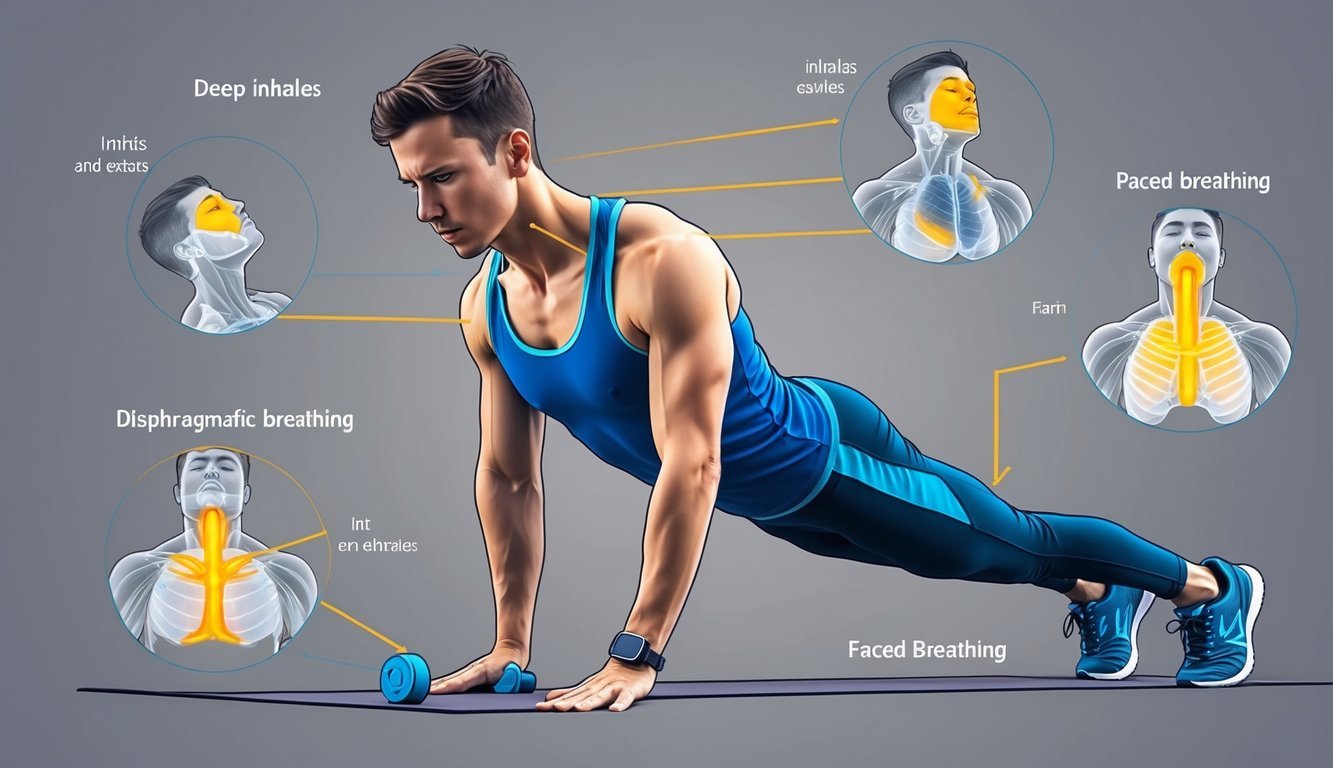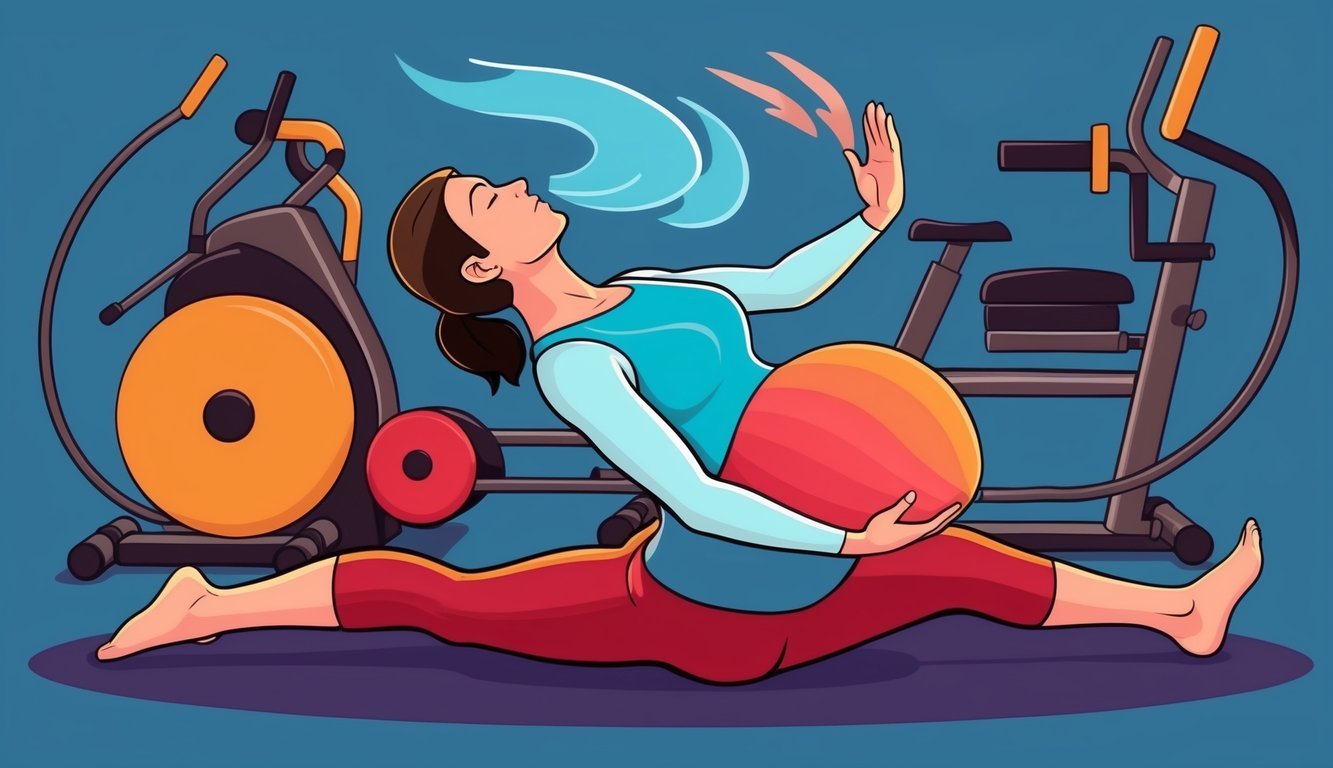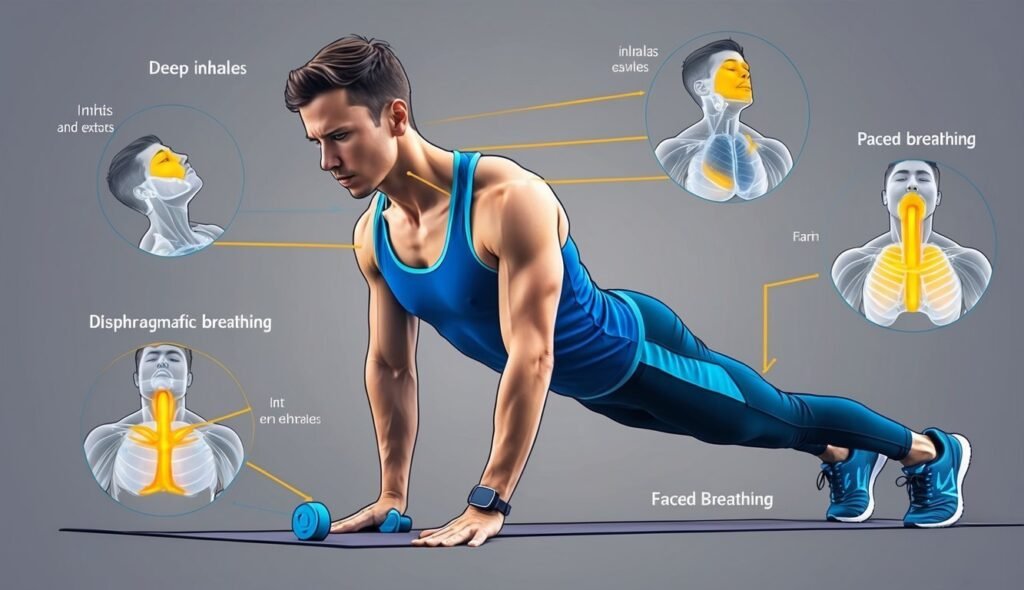You might have heard about how important breathing is for exercising, but have you ever thought about how it can actually boost your performance during high intensity workouts? Focusing on your breath can help you stay energized and improve your endurance.
This isn’t just about taking deep breaths; it’s about knowing which techniques to use when you’re pushing your limits.

When you use the right breathing techniques, you can enhance your workout and speed up recovery. These techniques don’t just keep you going during tough exercise sessions; they also assist in relaxing your body afterwards.
Discovering and practicing these methods can make a significant difference in how you perform and recover.
1) Box Breathing
Box breathing is a simple yet effective way to manage your breathing during high-intensity workouts.
It involves a steady rhythm to help calm your mind and body.
You breathe in, hold, breathe out, and hold again — each for an equal count, usually four seconds each.
This practice can improve your focus and keep stress at bay.
By controlling your breath in this structured way, you might find that you can push through those tough workout moments with a bit more ease.
It can be a great tool to have in your fitness arsenal.
Box breathing isn’t just for athletes.
It’s a technique used by Navy SEALs to manage high-stress situations.
So, next time you’re hitting a hard workout, try adding box breathing.
It could help you maintain your energy levels and stay focused on your goals.
2) Wim Hof Method
The Wim Hof Method is a popular breathing technique combining controlled breathing, cold exposure, and meditation.
Many athletes and fitness enthusiasts use it to boost their performance during high-intensity workouts.
This method involves deep, rhythmic inhalations and exhalations, followed by holding your breath for a set time.
Doing this helps you control your breath, which can improve endurance and focus during exercise.
Studies suggest that the Wim Hof Method can enhance breathing economy, helping you use oxygen more effectively.
Aside from the breathing exercises, the Wim Hof Method also includes cold exposure to increase resilience.
Some people say this combination reduces stress and enhances vitality.
It’s important to practice safely, making sure you’re in a comfortable space and listening to your body.
If you’re new to this method, try starting with the breathing exercises.
Focus on how you feel during and after each session.
Over time, you’ll gain more control over your breathing, which could benefit your high-intensity workouts.
Remember, consistency is key, and it’s essential to progress at your own pace.
3) 4-7-8 Breathing
The 4-7-8 breathing technique is a simple yet powerful method to help you manage stress and boost your performance during intense workouts.
It involves breathing in for four seconds, holding your breath for seven seconds, and exhaling for eight seconds.
This technique promotes relaxation and helps calm your mind.
By slowing down your breathing, you reduce feelings of anxiety and improve focus.
As an athlete, this can be crucial in maintaining composure during high-pressure situations.
4-7-8 breathing also helps regulate your heart rate.
This can be beneficial between sets or exercises, allowing your body to recover faster and perform at its best.
By practicing this regularly, you enhance your control over your body’s responses to stress.
Incorporating 4-7-8 breathing into your workout routine can improve not only your physical performance but also your mental resilience.
Next time you’re feeling overwhelmed, give this breathing technique a try and see the difference it makes.
For more insights on the impacts of the 4-7-8 method on training, check out this study.
4) Diaphragmatic Breathing

Diaphragmatic breathing is a simple but powerful technique.
It involves breathing deeply using the diaphragm, the muscle located just below your lungs.
This type of breathing helps increase lung efficiency and can improve your overall performance during workouts.
When you practice diaphragmatic breathing, you draw air deep into your lungs.
This can increase oxygen uptake and help in improving endurance and reducing fatigue.
It also encourages relaxation, which might help you feel more focused and calm during high-intensity exercises.
To try it, start by lying down in a comfortable position.
Place one hand on your chest and the other on your belly.
Inhale slowly through your nose, letting your belly rise more than your chest.
Exhale through your mouth or nose, watching your belly fall.
Incorporating diaphragmatic breathing in your workouts can enhance your performance because it utilizes more lung capacity.
This technique can also aid in reducing stress levels and improving concentration.
Some research suggests it can even help reduce stress in adults.
Practice regularly to make it a natural part of your exercise routine.
5) Alternate Nostril Breathing
Alternate Nostril Breathing is a calming technique that you can use to enhance your breathing efficiency.
This practice involves inhaling through one nostril while closing the other and then switching.
It helps keep your mind focused and can reduce stress during intense workouts.
To try this technique, sit in a comfortable position.
Use your thumb to close your right nostril and inhale deeply through your left.
Next, close your left nostril with a finger and exhale slowly through your right nostril.
Then, inhale through the right nostril while keeping the left closed.
Repeat the cycle by exhaling through the left nostril.
This pattern helps balance and improve your breathing capacity over time.
It might seem a bit tricky at first, but with practice, it becomes easier.
Many find alternate nostril breathing helpful before or after workouts.
It can be a soothing way to wind down or prep your body for physical activity.
You might notice an improvement in your focus and energy levels.
Incorporating this method could be a game changer.
You can read more about its benefits in resources like this book on breathwork for athletes.
6) Resonant Breathing

Resonant breathing is a technique that helps bring your body into balance.
The idea is to find a breathing rhythm that works well with your body.
Most people find this rhythm to be around 5-7 breaths per minute.
This method helps reduce stress and can boost your performance during high-intensity workouts by enhancing cardiovascular function.
To practice resonant breathing, start by sitting comfortably.
Inhale slowly, counting to five, and then exhale just as slowly.
The key is to keep a steady pace.
This steady rhythm can help manage anxiety and improve focus during tough workouts.
This kind of breathing has been shown to optimize blood pressure and heart rate.
When you breathe this way, your body and mind may feel more relaxed.
For more details, you can learn about this method through various studies on resonant breathing.
By incorporating resonant breathing into your routine, you might notice a significant difference in how efficiently your body handles high-intensity workouts.
7) Belly Breathing

Belly breathing is all about using your diaphragm to take deep breaths.
Instead of your chest rising, your belly should move outwards as you inhale.
This method helps bring more oxygen into your body, which is super helpful during intense workouts.
Practicing belly breathing can boost your performance.
When you breathe deeply, it reduces stress and helps you stay focused.
This can be especially useful for athletes and those engaging in high-intensity training.
You can start by lying on your back and placing a hand on your stomach.
As you breathe in through your nose, feel your belly expand.
Exhale slowly through your mouth.
Getting the hang of this technique during your workouts can make a big difference in your endurance.
Incorporating belly breathing into your routine is simple, yet effective.
It’s one of those things that doesn’t require much time but still offers great benefits.
If you’re curious about other breathing methods, you might find this book helpful.
It explores how different breathing techniques can enhance athletic performance.
Understanding the Importance of Breath

Breathing is key to boosting your performance and efficiency in high-intensity workouts.
It helps manage energy and impacts how well you handle physical stress.
Why Breathing Matters in High Intensity Workouts
During intense exercise, your body demands more oxygen to fuel muscles and maintain endurance.
Proper breathing techniques can maximize oxygen intake, improving stamina.
You need to switch between rapid and controlled breathing to keep up with the demands of the workout.
Proper breathing reduces fatigue and helps your muscles recover quickly.
It helps avoid early burnout by efficiently distributing energy.
Techniques like box breathing or 4-7-8 breathing are particularly useful in staying in control during rigorous sessions.
Connection Between Breath and Performance
The way you breathe affects your physical output directly.
By maintaining a steady rhythm, you can perform more consistently.
An effective breathing pattern boosts focus and coordination, reducing chances of injury.
Integrating breath control helps manage stress levels during workouts.
In high-pressure situations, keeping calm through breathing makes a difference.
Using techniques to hold your breath or control exhalation can simulate high-altitude training and improve athletic performance.
How Breathing Affects Your Body During Workouts

Breathing plays a big role in how your body and mind perform during workouts.
With the right techniques, you can boost your physical endurance and stay mentally sharp, making your workouts more effective and enjoyable.
Physiological Benefits of Proper Breathing
Proper breathing during workouts helps you get more oxygen to your muscles.
This means you can work out harder and longer without getting tired too quickly.
For instance, using techniques like box breathing or 4-7-8 breathing can help you keep a steady and efficient breath rate.
These methods not only enhance oxygen intake but also promote relaxation and endurance during workouts.
Incorporating controlled breathing exercises into your routine aligns with the best practices for lung health, ensuring that your respiratory system functions optimally.
By maintaining proper breath control, you can improve performance, reduce fatigue, and support overall well-being.
When you breathe deeply, your body is better at controlling energy and reducing lactic acid buildup.
This can minimize muscle fatigue and speed up recovery after intense sessions.
Good breathing also aids in controlling your heart rate, helping you stay calm and focused during challenging parts of your workout.
Mental Focus and Stress Reduction
Breathing isn’t just about getting oxygen.
It’s also a powerful tool for calming your mind.
Keeping a steady breath can reduce stress levels and maintain better concentration.
Slow, nasal breathing helps keep you in the zone by enhancing your focus and sharpening your mental clarity.
This increased focus can lead to improved performance.
You’ll be able to pay closer attention to your body’s signals and make adjustments mid-workout.
Relaxed breathing also reduces anxiety, making workouts a more enjoyable experience as you tackle each exercise with confidence.

